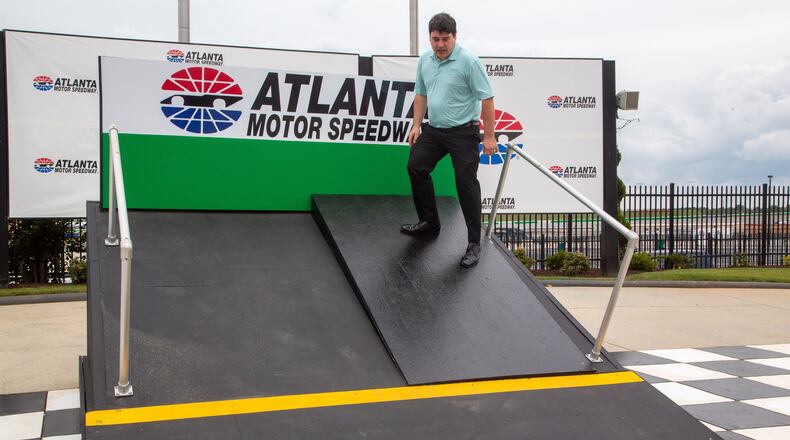To many, this is a story about roadwork, one of the more common – and infuriating – sights on any given Atlanta highway. But to those more in tune with the thrum of big-time racing, Tuesday’s announcement at Atlanta Motor Speedway represented, “an historic change, not just for (AMS) but for the industry, for the sport.”
That was the spiel of the speedway’s Executive Vice President and General Manager Brandon Hutchison when announcing a multi-million project to repave the track while also altering the pitch of the turns and the width of the straightaways.
The makeover – the first significant work on the track surface since 1997 – will begin almost as soon as someone takes the checkered flag in Sunday’s Quaker State 400 at the track. And is expected to be completed by late October, time enough to test it before the 2022 season and the introduction of NASCAR’s new Next Gen model car.
Drivers and fans can be resistant to change in this sport. And that’s certainly the case with the track surface at AMS. The rough and pitted mile-and-a-half that tended to treat very costly tires like a cheese grater does a block of cheddar had earned a grudging affection from those in the garage.
It was just less than three months ago when Todd Gordon, the winning crew chief behind Ryan Blaney at the Folds of Honor QuikTrip 500, pleaded, “No, don’t repave. Don’t repave. Don’t, don’t, don’t repave.”
But they will, will, will, will. “We’ve really not talked much to the drivers on this one,” said Stephen Swift, who is the manager for projects like this for the track owner, Speedway Motorsports. “We try to look at what’s good for the sport.”
And with a smile, he added, “When a driver’s happy about a racetrack, usually the fans aren’t. When the fans are happy, usually the drivers aren’t. We’re trying to find that happy medium.”
The defending NASCAR Cup champion is from Dawsonville and counts AMS as his home track. Chase Elliott was of the no-pave school for a long time, but has come around to the conclusion that, “I think it’s time for it. I’m good with it. I hope it’s for the better. I think it will be.”
Currently, Swift said, “There’s every different type of glue, stick-em, duct tape, you name it that’s on this racetrack holding it together.” Because of the drivers’ love for the surface, the track put off repaving until concerns about the track coming apart reached critical mass.
What really has gotten leadership’s engines revving, though, is the redesign of the track. Before the new pavement is laid, the banking on the turns will go from 24 degrees to 28 degrees, steeper than any other intermediate-sized track. That’s a geometry more in line with superspeedways like Daytona and Talladega and the charming half-mile bowl at Bristol.
Much of the rest of the track will be narrowed from 55 feet to 40 feet (with the front straightaway 52-feet wide) in an attempt to compact and improve the competition. Designers arrived at those dimensions after months of testing in the virtual world, and now await real-life results.
“It will create a more competitive, closer-racing experience,” Hutchison said. “It will produce a show like no one has ever seen on an intermediate track before.”
Credit: Steve Schaefer
Credit: Steve Schaefer
The idea being that cars can carry greater speed, with more control, into the steeper corners. The narrower lanes in the straightaways hold their own tension and mystery – “Narrowing the track up is probably the biggest headline of all that I read,” Elliott said.
And with the new surface, the tire conservation that has been such a big part of strategy here will be rendered largely meaningless. “They’ll be able to have longer runs with less tire wear, which will create more strategic, more competitive racing throughout the long run,” Hutchison said.
In other words, when race crews report with a new car to a newly remade Atlanta Motor Speedway next spring, they’ll be launching a voyage of discovery.
“It will be a clean slate,” Swift said. “They never ran a mile-and-a-half with this type of embankment. ... It will be a complete different notebook; they’ll have to start from scratch.”
Announcing this big project on the week that AMS will hold its second race of the season – it had lost that second race on the schedule in 2011 – was significant. It signaled confidence in being able to hold onto that second date over the long run.
“This is a significant investment, a significant project, a multi-million dollar project,” Hutchison said. “I think it’s safe to say you’ll see two races at Atlanta Motor Speedway in 2022.”
He later added, “It’s definitely something that will enable us to have a second race for quite some time.”
About the Author
Keep Reading
The Latest
Featured



